STUDENTS PROJECTS
PROJECTS2012
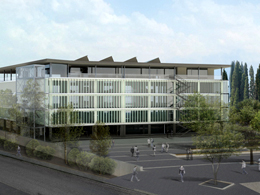
24 May, 2013
Memory nd urban sityscape
Adaptive reuse of 2 tobacco warehouses in Thessaloniki.
Student : Leandros Zoidis
Supervisor: Prof. Rena Sakellaridou
School : Faculty of Architecture, Polytechnic School, Aristotle University of Thessaloniki
Date: 28th September 2012
The trade and processing of tobacco had been for many decades a main occupation of people in northern Greece. Stavroupoli (Terpsithea) is an area of Thessaloniki with a dynamic and active part of the population. Its history is very closely connected with tobacco processing. Through the adaptive reuse of two significant tobacco warehouses into a mixed-use complex, the present thesis aims to offer new perspectives of evolution and development to the area, bringing to the foreground its rich but «inaccessible» urban memory.
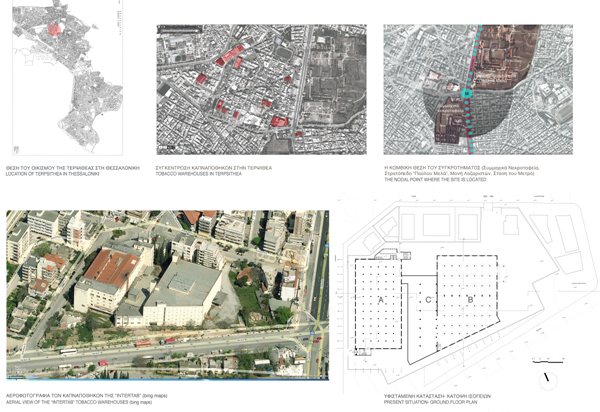
Location of the site.
The site of the «Intertab» Tobacco Warehouses is located in the area of Terpsithea in Stavroupoli, Thessaloniki. The area extends around former "Lasaristes Monastery", which now operates as a cultural centre which also hosts the State Museum of Contemporary Art", and is defined by several main roads of Thessaloniki such as Langada Str., and Akriton Str.. The area used to belong to the Monastery, which was gradually selling its estate to other owners.
In the 1930s a plan for the urban development of Terpsithea was approved. After World War II, a lot of enormous tobacco warehouses were built in the area. As a result of this, the workers of the warehouses settled around them and built their homes. The warehouses are an important part of the area 's memory and history and they are currently form an exceptional urban condition. Their volume and simplicity contradicts the fragmented image, typical of a contemporary greek town.
This design thesis considers the abandoned building structures of the warehouses as findings, which present an important chance for the future development of Terpsithea, and Thessaloniki as a whole. Basic objective is the emergence of the area' s latent historic memory. This can only be achieved through the conservation of the buildings, their successful integration in their environment and the sustainable restructuring of their interiors.
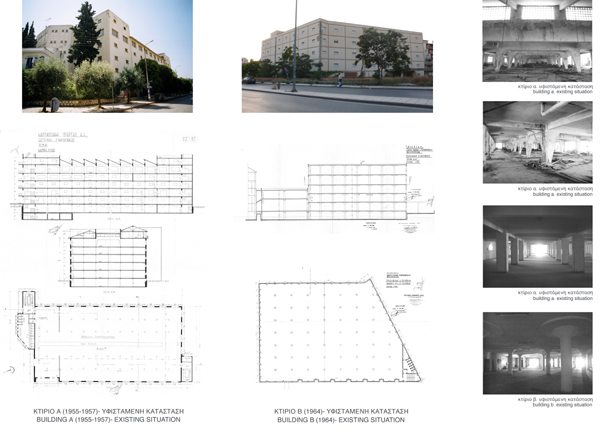
The «INTERTAB» tobacco warehouses.
From the several warehouses of the area, the "INTERTAB" complex was chosen, due to its architectural interest and qualities and its highly nodal point and its proximity to Langada Str., the former "Pavlou Mela" barracks, the Allied Cemetery of Zeitenlik and the State Museum of Contemporary Art. The "Pavlou Mela" barracks is planned to be transformed into a significant urban park. Moreover, a metro station is being planned on the crossroads of Langada and Akriton Str., with an exit straight onto the warehouse site. This project aims that the transformed warehouses, along with the other, present and future, attractions of the area form a new center for western Thessaloniki, which currently does not exist.
The INTERTAB complex consists of three buildings. The first one (Building A) was design and built between 1955 and 1957 by a modernist architect of the city and several architectural qualities and influences are acknowledged, according to extensive research. The two newer buildings (Building B, Building C, 4 and 2- stories respectively), works of a civil engineer in 1964, are not of particular interest. In the 4-storey building, though, the mushroom columns create a very special organic atmosphere. Despite the fact that they are neglected, all 3 of the buildings are structurally in good condition. Today, most of their spaces are not in use, apart from their ground floor, which hosts an amazing collection of antique cars, only accessible to the owners.
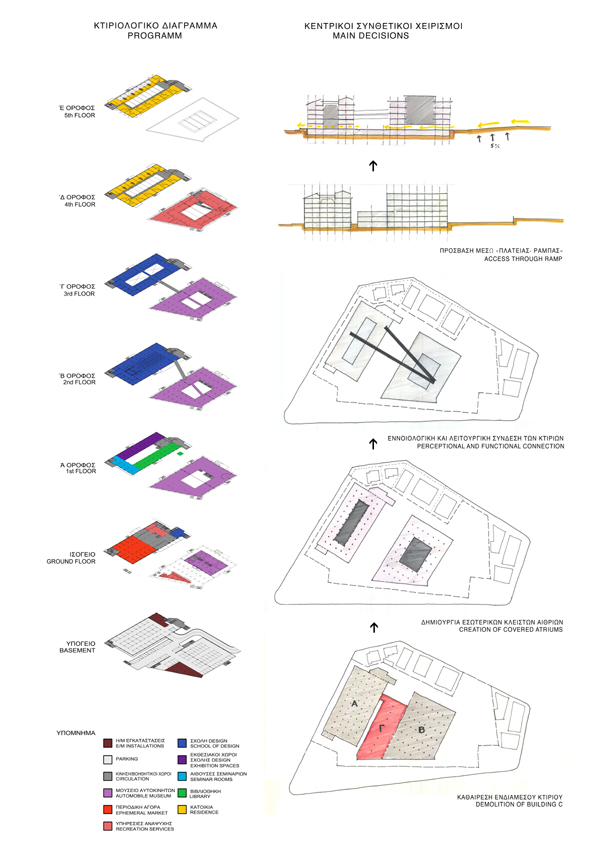
Program and Main Decisions.
Basic decision of the design proposal is the creation of a mixed- use program. One reason for this is certainly the big amount of available surfaces (~28,000m2 in existing, ~20.000 in proposed). The uses proposed are affected the facts and needs of the area. The existence of such the automobile collection is certainly an important factor. Furthermore, a museum additional to the State Museum of Contemporary Art and the Lazaristes' theatrical events and concerts would form a cluster of cultural activities. The second main use proposed is a graduate school of industrial design. Industrial design is closely related to automobiles and the particular school would try to form a cluster of educational activities, along with some existing faculties of the School of Fine Arts that are located in the area. Additional uses include residences (26 appartments), ephemeral market places, recreation,bars, restaurants and parking places and aim to ensure the continuous function, safety and sustainability of the buildings.
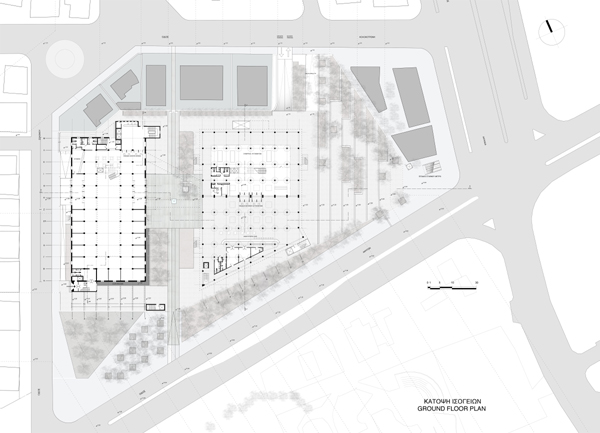
Ground Floor Plan.
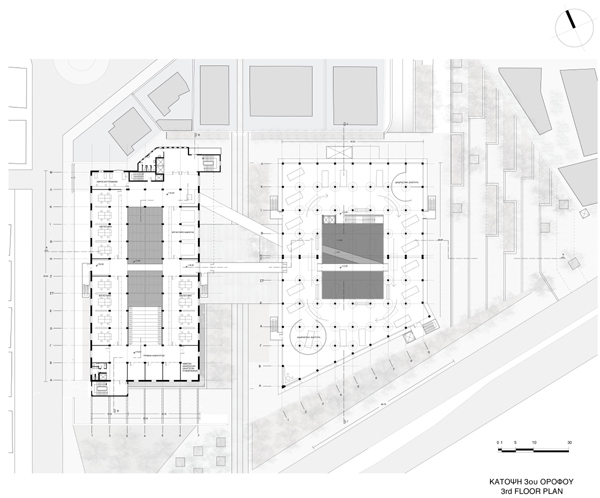
3rd Floor Plan.
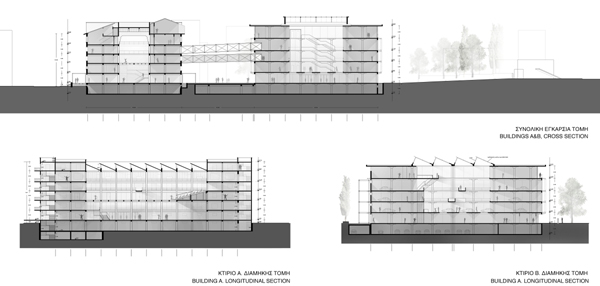
Sections.
The biggest challenge of the project was the integration of the former warehouses to their surrounding environment. Aim is the synergy among the ground floors, the open spaces and the urban context to create a united perception of space, which consists of functionally alternating and cooperating free and covered surfaces. The difference in level between the buildings' ground floor and the pavement at Langada Str. (1.50μ) is covered with a big ramp, which is also providing access to the site from the metro station. This slope has an elevation of about 4.5% and is the key to the unification of the 1st level zone and the integration of the buildings to their wider urban context. This "sloping piazza" is paved with concrete mosaic, offers a lot of shaded spaces and is supported by a semi- open bar at the first level of building B.
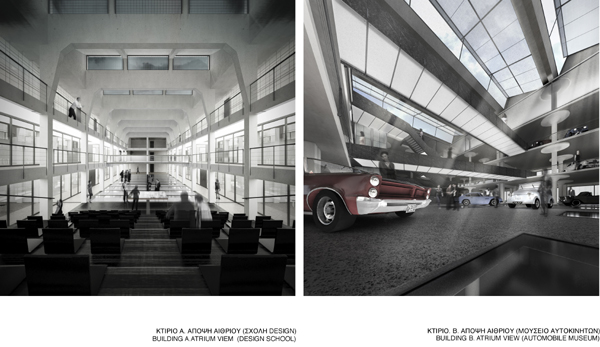
Inner Views.
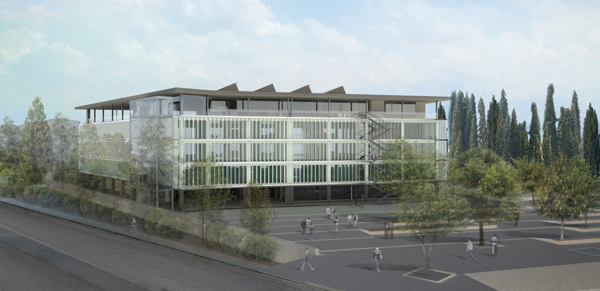
Outer Views of building B and «piazza».
The excessive width of the buildings (30m in A, 40m in B) made the creation of covered atriums necessary, which form the basis of the buildings' internal function (7). The notional, morphological and functional connection of the buildings is achieved through two metal-frame bridges, which continue into the atriums in order to create some episodes (7). The new ensemble aspires to be energy sufficient through the installation of photovoltaic elements on the atrium sheds of both buildings (6,9,10) as well as in the new double skin façade of building B, which is made of vertical glass blinds (8).
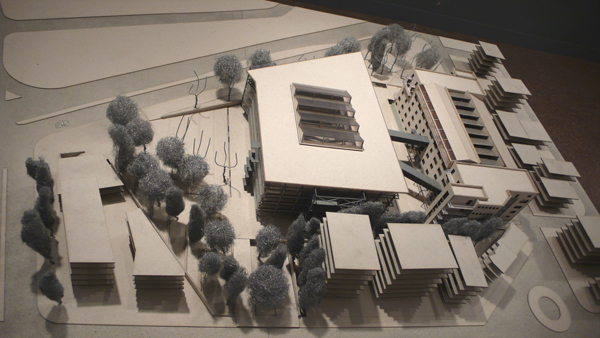
View of the model.
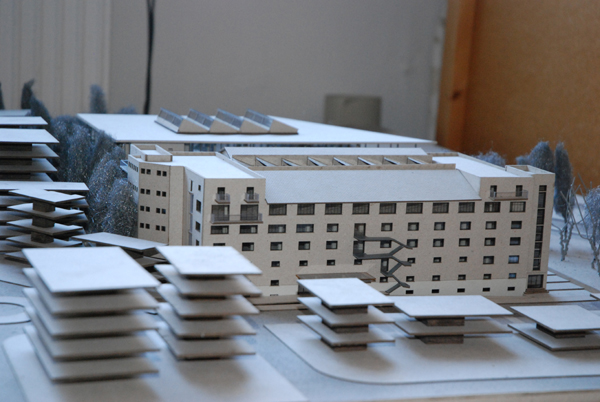
View of the model. Building Α.
Related articles:
- Industrial Building on the fringes of Attiki Odos ( 15 November, 2009 )
- MEDICAL INSTRUMENTS FACTORY AT RAFINA, ATTICA ( 20 October, 2009 )
- Reutilisation of the building T.A.O.L. in Lefkada ( 23 June, 2010 )
- Routes in the paths of emery ( 01 February, 2011 )
- Urban integration and reuse of the former paper industry of Ladopoulos in Patras ( 20 February, 2011 )
- The old factory of Azel ( 04 April, 2011 )
- Restoration and reuse of the Tzivre silk mill in Soufli ( 14 June, 2011 )
- Project Suggestion for Reusing KOMDE’s industrial complex in Trikala ( 16 August, 2011 )
- Mining Museum in Serifos ( 15 February, 2012 )
- Multi-space of Meditteranean Diet in metropolitan park in Goudi ( 05 March, 2012 )
- Subverting the non use ( 26 March, 2012 )
- Cultural Park in inactive lignite mines of Ptolemaida ( 27 September, 2012 )
- Winery in Nemea ( 01 May, 2012 )
- Industrial landscape in Aliveri ( 16 August, 2013 )
- Decontamination and Production Mechanism ( 05 February, 2014 )
- Reformation and rehabilitation of an inactive quarry, with spatial location of uses for Tourism, Recreation and Environmental Education ( 10 February, 2014 )
- Redesigning the silo at the historic Allatini Mills ( 09 May, 2014 )
- Restructuring the Industrial Landscape ( 19 July, 2014 )
- inte[R]outes ( 11 December, 2014 )
- Lato and Kekrops Quarries: a walk in the residual landscape ( 28 January, 2015 )
- Print your utopia ( 07 February, 2015 )
- ADAPTIVE REUSE OF A FORMER PAPER FACTORY IN AIGIO AND CONVERSION TO REHABILITATION CENTRE FOR DISABLED PEOPLE ( 12 August, 2015 )










